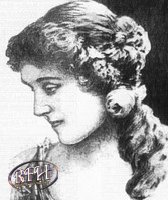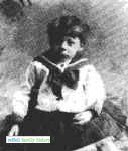Special note: It is not the intention of this website to judge any ancestor, regardless of how serious any actions they may have made. Firstly it is unfair to put our current day values on the very different circumstances of their lives, and secondly we have often only very biased accounts from the time to go on. With this in mind, the following account tries to be unemotional, sticking to the facts as reported, but also at the same time trying to explain the personal anguish of all the friends and family involved.

Louise Josephine Jemima Masset was born on 15 June 1863 at 109 Guildford Street Russell Square, and baptised on 5 July 1863 at Holy Trinity Graves End Road. She was the second of three daughters of Etienne Ernest Magloire Masset & Elizabeth Rebecca Reffell, and was a granddaughter of Henry Hatch Reffell. There was also a younger brother who died at an early age. Louise became the first person to be executed in Britain in the 20th century, being hanged at Newgate prison on 9 January 1900 for the murder of her three year old son, Manfred Louis Masset.

Manfred Louis was born in May 1896 at 17 Highgate Hill Upper Holloway, and baptised on 19 May 1896 at St Peter Dartmouth Park Hill, his father’s name was shown as Maurice who was believed to be a French resident. Louise and Manfred lived with her sister Leonie Ernestine Mary Anne at 29 Bethune Road Stoke Newington. In order for her to work as a day-governess for a wealthy family, Manfred was put into foster care with Mrs Helen Gentle from Tottenham. On 16 October 1899 Mrs Gentle received a letter from Louise that told her that Manfred was going to live with his natural father in France and that she would collect him to take him there three days later. On that date Louise picked up Manfred together with a parcel of clothes that Mrs Gentle had packed for him and took a bus to London Bridge railway station. Mother and son were last seen together in a waiting room there at around 3 o’clock in the afternoon, but around 6 o’clock that evening Louise was seen on her own catching a train for Brighton. About twenty minutes later, the battered body of a male child was found in the ladies toilets at Dalston Junction station. Mrs Gentle identified the body as Manfred and was also able to identify the parcel of clothes which she had made up for him, which was later found in the left luggage office at Brighton station.
Louise was tried at the Old Bailey before Mr Justice Bruce between 13-18 December 1899. Her defence was that she had made an agreement for two women called Browning to look after Manfred for a period and that it must have been them who murdered him. However, the two Browning women could not be identified and she was found guilty of murder. It was reported in the press that she appeared to show no emotions or remorse at all during her trail, and the death penalty was announced by the judge.
A petition for clemency was presented, citing an alleged widespread history of insanity within the family ancestors, and this had been signed by virtually all of her close relatives. Included within the papers which are now at the National Archives, are a number of moving documents that help to explain Louise’s state of mind at the time. She had been severely affected by the death only a month before of her step father Peter Armstrong (1822-1899), to whom she was very close. It also appears that she had recently been rejected by Manfred Louis’s father and the letters that she wrote to the child’s father still survive in the archives. These are quite detailed, and includes the following passage ‘you know as well as I that your son will never be received in my family. They have told me often enough.’ It appears that the step-father would not accept her son unless she told them the name of his father, but she would not divulge it. She then says ‘What will they say when they see me one day come back with Manfred – Or rather I do not think I shall ever have courage to bring the child to the house, then we will have to stop without shelter that is all, for I have promised not to speak about you and if I bring back the child they will force me to say your name’. These do not sound like the words of the callous mother pilloried in the press at the time.
There was however to be no reprieve. On the morning of 9 January 1900 a bellman recited the execution verse at St Sepulchre, and at 9 o’clock she was hanged opposite the church at Newgate Prison. Like those executed before her, she was buried in limestone under the flagstones in Birdcage Walk at the prison.
One petition had been prepared by George Simes (1867-1935), the husband of Louise’s sister Mathilde Georgina Alexandrine Masset, who was an auctioneer. Tragically, although not clear as to whether from the effects of the events or not, Mathilde was to die later that year, followed by grandmother Elizabeth Rebecca three years later. Such were the tragic consequences of that sad day.